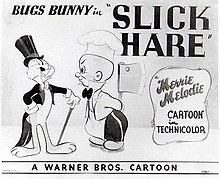Slick Hare
| Slick Hare | |
|---|---|
 | |
| Directed by | I. Freleng |
| Story by | Tedd Pierce Michael Maltese |
| Produced by | Edward Selzer (uncredited) |
| Starring | Mel Blanc Arthur Q. Bryan (uncredited) Dave Barry (uncredited) |
| Music by | Carl Stalling |
| Animation by | Virgil Ross Gerry Chiniquy Manuel Perez Ken Champin |
| Layouts by | Hawley Pratt |
| Backgrounds by | Paul Julian |
| Color process | Technicolor |
Production company | |
| Distributed by | Warner Bros. Pictures The Vitaphone Corporation |
Release date |
|
Running time | 7:43 |
| Language | English |
Slick Hare is a 1947 Merrie Melodies cartoon, directed by Friz Freleng.[1] The film was released on November 1, 1947, and features Bugs Bunny and Elmer Fudd.[2] It parodies the Mocambo nightclub in Los Angeles—in the cartoon referred to as "The Mocrumbo". Mel Blanc voices Bugs, Arthur Q. Bryan voices Elmer Fudd and impressionist Dave Barry portrays Humphrey Bogart. The title is a pun on "hair", from an era when hair slicked down by oil was a popular fashion style for men.
Plot
[edit]The cartoon commences with a satirical portrayal of 1940s Hollywood luminaries indulging in culinary extravagance at the Mocrumbo club, replete with exaggerated antics and whimsical nods to iconic personas.
Amidst the glamorous milieu, Elmer Fudd, cast as a hapless waiter, encounters the formidable Humphrey Bogart, whose demand for fried rabbit sets off a chain of absurd events. Elmer's frantic quest for a rabbit leads him to an unwitting Bugs Bunny ensconced amidst crates of carrots, igniting a miscommunication that sees Bugs fleeing from the impending dinner invitation.
Bugs' escapades unfold in a series of comedic encounters, from a failed disguise reminiscent of Groucho Marx to a frantic pursuit through the eccentricities of a showbiz setting, including encounters with Carmen Miranda and Sydney Greenstreet.
As the tension mounts, Bugs' quick-witted antics and Elmer's hapless endeavors culminate in a chaotic climax, with pie-slinging antics and mistaken identities punctuating the farcical proceedings. Ultimately, Bugs' comedic prowess prevails, as he ingeniously assumes the role of Lauren Bacall's main course.
Cast
[edit]- Mel Blanc as Bugs Bunny, Waiter, Bartender and Ray Milland
- Arthur Q. Bryan as Elmer Fudd (uncredited)
- Dave Barry as Humphrey Bogart (uncredited)
Production
[edit]Background artist Paul Julian visited the kitchen at the Mocambo, and based this cartoon's kitchen backgrounds on the unhygienic things he observed, later commenting in an interview: "I was so bloody revolted by it that I came back and made a documentary out of it!"[3]
Reception
[edit]Cartoon voice actor Keith Scott writes, "One of the last of Warner Bros.' topical caricature cartoons, Slick Hare is much more accessible to a modern audience than some other entries in the movie-star parody genre. This is because Bugs Bunny and Elmer Fudd carry the comedy. With these two strong personalities in the foreground, the throwaway movie-star gags are more like the icing on a cake."[4]
Home media
[edit]- This cartoon can be found on the Looney Tunes Golden Collection: Volume 2.
- The short is also an extra on the DVD release of the 1947 Humphrey Bogart film Dark Passage, available individually and as part of the Bogie & Bacall: The Signature Collection DVD boxed set.
See also
[edit]- List of Bugs Bunny cartoons
- Mickey's Gala Premiere
- Mickey's Polo Team
- Mother Goose Goes Hollywood
- The Autograph Hound
- Hollywood Steps Out
- Hollywood Daffy
- What's Cookin' Doc?
- Felix in Hollywood
References
[edit]- ^ Beck, Jerry; Friedwald, Will (1989). Looney Tunes and Merrie Melodies: A Complete Illustrated Guide to the Warner Bros. Cartoons. Henry Holt and Co. p. 179. ISBN 0-8050-0894-2.
- ^ Lenburg, Jeff (1999). The Encyclopedia of Animated Cartoons. Checkmark Books. pp. 60–61. ISBN 0-8160-3831-7. Retrieved 6 June 2020.
- ^ Michael Barrier. "Slick Hare" on Looney Tunes Golden Collection: Volume 2 (Region 2 DVD release) (DVD commentary). Event occurs at 5m41s.
Paul Julian actually did research for the backgrounds of this cartoon by going to the kitchens of the real Mocambo and reproducing in the film some of what he saw there, which evidently ruffled some feathers as Paul explains in this interview with my colleague Milton Gray: "... I went and looked at the back kitchen at the Mocambo, and I almost got my ass in a sling because in the film I reported what I saw! Fingerprints and disgusting puddles oozing out from under crates of food stacked in the corner... greasy fingerprints, all kinds of... just unbearable! I was so bloody revolted by it that I came back and made a documentary out of it!"
- ^ Beck, Jerry, ed. (2020). The 100 Greatest Looney Tunes Cartoons. Insight Editions. p. 172. ISBN 978-1-64722-137-9.
External links
[edit]- Slick Hare at IMDb
- 1947 films
- 1947 short films
- 1947 animated films
- Merrie Melodies short films
- Films about Hollywood, Los Angeles
- Short films directed by Friz Freleng
- Animated films set in Los Angeles
- Animation based on real people
- Cultural depictions of actors
- Cultural depictions of Humphrey Bogart
- Cultural depictions of the Marx Brothers
- Cultural depictions of Frank Sinatra
- Films scored by Carl Stalling
- Bugs Bunny films
- Elmer Fudd films
- 1940s Warner Bros. animated short films
- Films with screenplays by Michael Maltese
